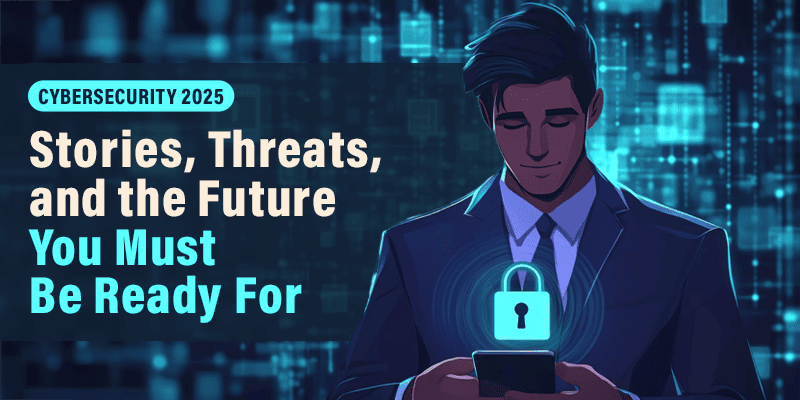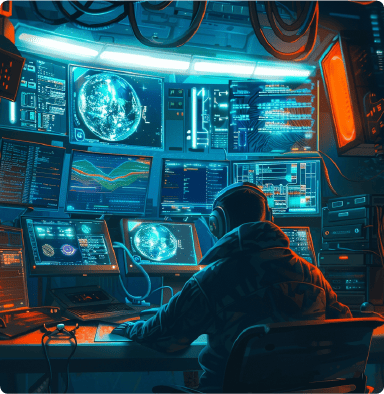Cybersecurity 2025: Stories, Threats, and the Future

“The future is already here—it’s just not evenly distributed.”
This famous quote by William Gibson, the visionary author of Neuromancer, rings truer than ever in the realm of cybersecurity.
While some organizations are already living in tomorrow, wrestling with quantum threats and AI-driven attacks, others are still grappling with challenges that feel distinctly yesterday. But what if we told you that 2025 isn’t some distant horizon, but a critical inflection point already upon us?
Forget the dry technical reports; the true narrative of cybersecurity isn’t just about firewalls and encryption. It’s about human ingenuity against relentless adversaries, the silent battles waged in the digital shadows, and the profound impact these conflicts have on our everyday lives.
In this deep dive, we’re not just predicting the future; we’re exploring the stories that are shaping it right now. Get ready to confront the quantum leap in threats, the cunning evolution of ransomware, and the sophisticated deceptions of deepfakes.
Breaches That Shook the World in recent years
These are recent or notable breaches and incidents — each shows a different kind of risk and what can go wrong (and how to guard against it).
Jaguar Land Rover Production Shutdown
A cyberattack forced the company to shut down production lines and send employees home. The Times of India
Even manufacturing / operational continuity is vulnerable; attacks can ripple out through supply chains. Businesses need to protect OT/IT convergence.
St. Paul, Minnesota Digital Attack
In mid-2025, the city suffered a coordinated digital attack disrupting municipal systems; state called in the National Guard. Wikipedia+1
Shows that local government infrastructure is a target. Public services, utilities, online payments etc. can be taken offline. Resilience is necessary.
IRLeaks Attack on Iranian Banks
~20 out of 29 banks were hit, massive disruption, ransom demands, stolen data of millions. Wikipedia
Financial sector is always high-risk; mass impact events can cascade into economic instability. Emphasizes need for robust incident response, backup systems, and cross-bank coordination.
Kyivstar Telecom
Attack
Telecom provider attacked; service disruptions impacted millions of users.
Wikipedia
Telecom & infrastructure are critical—if communications go down, many services collapse. Redundancy, disaster recovery, and secure telecom architectures are not optional.
CrowdStrike Outage
A faulty software update caused 8.5 million Windows systems to crash globally, disrupting critical services. Wikipedia
Even cybersecurity firms can be vectors for widespread failure. Highlights the need for rigorous testing, backup systems, and vendor risk management.

Emerging Threats & Quantum on the Horizon
The cybersecurity landscape is evolving rapidly. Here are the critical threats shaping our digital future.
Quantum Risk
Encryption we rely on today (RSA, ECC) could be broken by future quantum computers. Hackers are already using “harvest now, decrypt later” tactics (NIST).
Zero-Day & Supply Chain Attack
Unknown flaws or third-party software holes can be exploited before detection. The SolarWinds hack is a classic case (CISA).
Deepfakes & Social Engineering
Cybercriminals use AI to mimic voices/videos. Fraudsters tricked a UK firm into transferring $243,000 using voice imitation (Forbes).
Ransomware Evolution
Today’s attacks not only lock data but also steal and threaten to leak it (IBM Report).
Innovation in Action: Projects from Our Participants
At REVA Academy for Corporate Excellence (RACE), our participants don’t just learn theory — they work on real-world projects tackling tomorrow’s problems. Here are a few powerful examples:
Enhanced Anomaly Detection in Secure Cloud Networks Using Machine Learning
Built and tested multi-algorithm models (using UNSW-NB15 dataset) for anomaly detection in cloud networks, achieving ~97.8% accuracy. Strengthens cloud security against evolving threats.
An Improved Method of Phishing URL Detection Using Machine Learning
Developed a phishing URL detection system using feature engineering and supervised ML models, with Random Forest achieving ~96.3% accuracy. Helps organizations safeguard against fraudulent websites.
Threat Modeling of Cloud based Implementation of Homomorphic Encryption
Using the STRIDE framework to map out attack surfaces and design mitigations. Very relevant for cloud providers, fintech, or any SaaS handling encrypted data.
Data Sanitization & Privacy Preservation Method on Edge Nodes
Protects data on IoT/edge devices using AES, RSA, data masking. Good for industries doing real-time analysis (e.g. healthcare wearables, factory sensors).
Unmasking The Shadows: A Multi-Dimensional Approach for Cyberbullying Detection
Deep learning (CNN, LSTM etc.) used to classify content, detect hate speech / harassment. Useful for platforms that moderate user content.
Using MNIST Dataset for De-Pois Attack and Defense
Studied how ML models can be corrupted by bad training data, then implemented defense strategies. Applies to any AI deployment.
…and more check out here.
“It takes 20 years to build a reputation and a few minutes of a cyber-incident to ruin it.”
Stéphane Nappo, Global CISO
Closing Thoughts
- Cyber threats are not just a “cybersecurity team’s” problem: they touch operations, financials, and reputation.
- Quantum computing isn’t here yet at full scale, but the risk window (for data being harvested & decrypted later) means planning matters now.
- You can become part of the solution—whether by leading projects, choosing the right technologies, or pushing for better governance.
Ready to Shape the Future of Cybersecurity?
As Bruce Schneier once said, Security is not a product, but a process. For working professionals, that process begins with building the right expertise, practicing with real-world challenges, and staying ready for what’s next.
At RACE, our M.Tech/M.Sc. in Cybersecurity is designed to nurture exactly that mindset — blending rigorous academics, hands-on projects, and industry mentorship to prepare professionals who can turn challenges into opportunities.
The only way to do great work is to love what you do
— Steve Jobs
In cybersecurity, that love translates to an unwavering commitment to understanding, adapting, and innovating.



